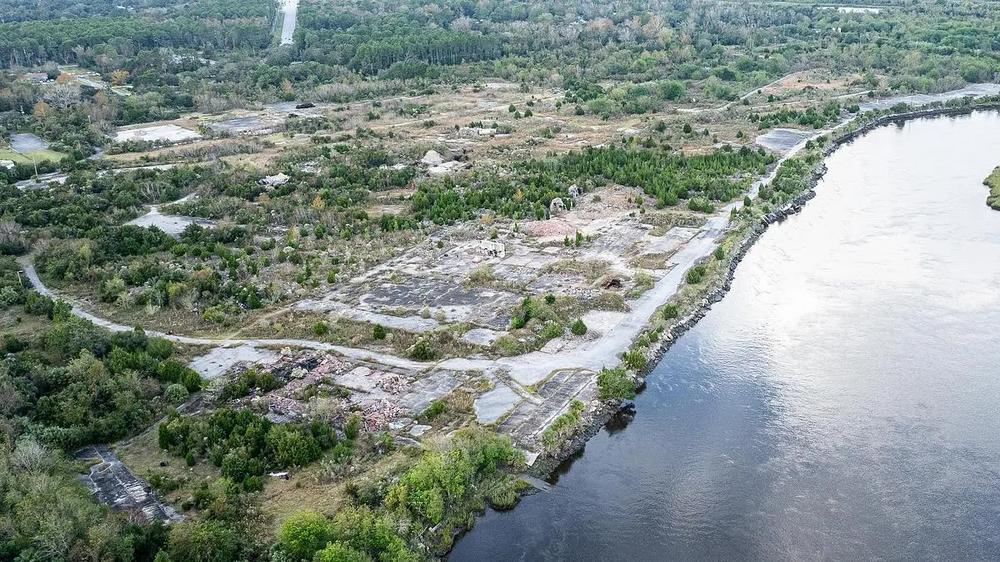
Caption
The former Gilman Paper mill site in St. Marys, GA on November 20, 2024, where Jacoby Development purchased more than 700 acres for the planned Cumberland Inlet development.
Credit: Justin Taylor / The Current

The former Gilman Paper mill site in St. Marys, GA on November 20, 2024, where Jacoby Development purchased more than 700 acres for the planned Cumberland Inlet development.
By Maggie Lee, The Current
The public agency that wants to see redevelopment at St. Marys’ old Gilman Paper site had a “nerve-wracking” few days this fall when the private developer there faltered on a $736,000 payment.
The Camden County Joint Development Authority voted on Sept. 30 to pursue foreclosure if necessary against JDI Cumberland Inlet LLC — a development partnership mostly owned by Atlanta developer Jim Jacoby’s Jacoby Development. The public body had borrowed nearly $11 million to help the company get started on part of the 719-acre site and a payment was due to the bank.
The latest hiccup in the planned megadevelopment triggered discussions about what happens if there’s a failure by the Atlanta developer with a long track record in turning around big projects on polluted municipal sites.
Jacoby Development turned a dead Atlanta steel mill into Atlantic Station, now the site of highrises, Ikea and other shops. Jacoby redeveloped an old Ford factory site near Atlanta’s airport into Porsche’s North American headquarters and test track. He plans to rebuild St. Marys’ waterfront as an ecotourism base camp with a marina, a RV park, a hotel, home rentals and commercial space.
In 2023 and earlier in 2024, Jacoby’s company made repayments to Camden’s development authority on time. But with an August payment past due, a foreclosure sale could have happened as early as Nov. 5.
A smaller developer was close to buying land for an assisted living center at Cumberland Inlet but backed out at the last minute in August, said James Coughlin, executive director of the county JDA. So no timely payment arrived from that developer or Jacoby for the development authority to pay back the bond money to the bank.
“And then Jacoby, several weeks later, came through and made the payment himself. But yeah, that was a very nerve-wracking time,” Coughlin said. “We didn’t like doing that. Fortunately, we never had to draw on the county. We never had to reach out to the taxpayers of Camden County. We never had to ask the city of St. Marys to make the payment. We had the money.”
Counties and some cities routinely offer valuable perks and partnership to developers of what would eventually be valuable, taxable properties. Those subsidies are often listed on public websites and can include state tax breaks, local property tax breaks and cash to prep land.
The idea, say development authorities, is that a municipal or county government needs to give something to get some benefit— jobs, or higher tax revenues — or some other county might offer more incentives and lure a development deal away.
Of course, other towns don’t have St. Marys’ acres of waterfront property or the valuable marina permit that the development authority has. But still, the site is big, and building takes more preparation due to old industrial pollution. From the local government’s point of view, Cumberland Inlet would be a much better thing to have in St. Marys than an abandoned paper mill. So they’ve decided to use some public resources to help make it happen.
Coughlin said if worse came to worst, if they did have to foreclose, the land would be available for purchase at a foreclosure sale or it could be subdivided and pieces sold. But he predicts there would be interest in the site.
“We won’t have any trouble selling off waterfront property if we have to pay ourselves back,” Coughlin said. He also said that St. Marys real estate is much more in-demand than it was back when the paper mill closed down and the county and city first started trying to figure out what they’d like to see at the site.
Coughlin also said that Jacoby is actively bringing other potential investors and subdevelopers to the site, including one visitor scheduled the first week in December.
Reached for comment, Jacoby himself said, “there’s a lot of interest, a lot of strong interest, and the project is moving forward.”
The next bond payment of about $190,000 is due in February.
This story comes to GPB through a reporting partnership with The Current.